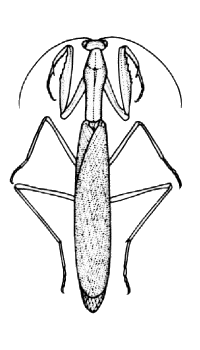Mantodea
Pronunciation: [Man⋅TO⋅de⋅a]
Pronunciation: [Man⋅TO⋅de⋅a]
Common Name: Mantids / Praying Mantids
Greek Origins of Name: Mantodea is derived from “mantis”, the Greek word for these insects.
Hemimetabola, i.e. incomplete metamorphosis (egg, nymph, adult)
Polyneoptera, closely related to Orthoptera and Blattodea
Common in tropical and subtropical climates. Approximately 1 family and 28 species in North America and 8 families and ~2,500 species worldwide
Mantids have elongate bodies that are specialized for a predatory lifestyle: long front legs with spines for catching and holding prey, a head that can turn from side to side, and cryptic coloration for hiding in foliage or flowers. Mantids are most abundant and most diverse in the tropics; there are only 5 species commonly collected in the United States and 3 of these have been imported from abroad.

Generally considered to be highly beneficial insects because they feed on other insects. Since they are cannibalistic and also feed on other beneficial insects, their value as biocontrol agents is probably rather limited.
Mantidae — this family includes all of the common North American mantids.
 The European mantid (Mantis religiosa) is a beneficial predator that has been purposely introduced throughout much of the world as a biological control agent. The island country of Dominica, a former British colony located in the West Indies, issued this stamp on December 29, 1988.
The European mantid (Mantis religiosa) is a beneficial predator that has been purposely introduced throughout much of the world as a biological control agent. The island country of Dominica, a former British colony located in the West Indies, issued this stamp on December 29, 1988.